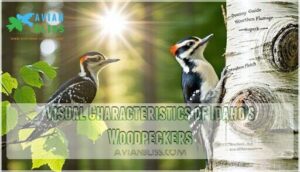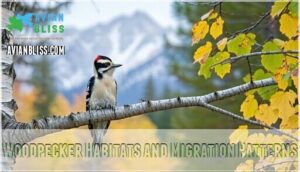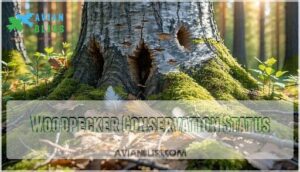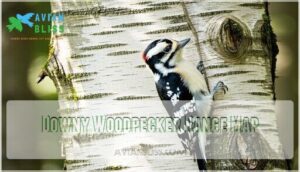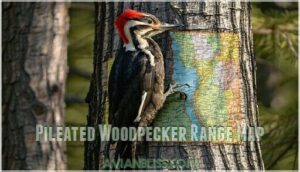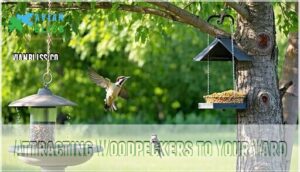This site is supported by our readers. We may earn a commission, at no cost to you, if you purchase through links.

Idaho’s diverse forests host both year-round residents like the Northern Flicker and seasonal visitors such as the Lewis’s Woodpecker.
The state’s burned areas and pinelands create perfect habitat for species like the Black-backed Woodpecker, while mixed forests support Williamson’s Sapsuckers.
Whether you’re exploring Boise’s foothills or the Sawtooth Mountains, you’ll encounter these remarkable birds drumming on dead snags, excavating nest cavities, and controlling insect populations.
Each species has evolved unique adaptations that make identification surprisingly straightforward once you know what to look for, making them remarkable birds with a role in controlling insect populations.
Table Of Contents
- Key Takeaways
- Woodpeckers Found in Idaho
- Woodpecker Identification
- Woodpecker Habitats and Migration Patterns
- Woodpecker Behavior and Diet
- Woodpecker Conservation Status
- Largest Woodpecker in Idaho
- Common Woodpeckers in Idaho
- Woodpecker Range Maps
- Attracting Woodpeckers to Your Yard
- Interesting Woodpecker Facts
- Frequently Asked Questions (FAQs)
- What is the largest woodpecker in Idaho?
- Is it good to have woodpeckers around your house?
- What bird looks like a woodpecker but is not?
- What does it mean when a pileated woodpecker visits you?
- Do woodpeckers live in Idaho?
- How many woodpecker species are there?
- Where do woodpeckers live?
- Where do white-headed woodpeckers live?
- How do you identify a woodpecker?
- Are woodpeckers good to have around?
- Conclusion
Key Takeaways
- You’ll discover that Idaho is home to around 15 species of woodpeckers, ranging from the tiny Downy Woodpecker to the large Pileated Woodpecker, each with unique adaptations and characteristics.
- You can attract woodpeckers to your yard by creating a welcoming environment with woodpecker-friendly plants and trees, using bird feeders and suet, and providing water sources and insect attractants.
- You’ll find that woodpeckers play a crucial role in controlling insect populations and maintaining ecosystem health, making them a valuable presence in your yard and a fascinating species to learn about.
- You don’t need to be an expert to start learning about woodpeckers – you can begin by exploring their unique characteristics, habitats, and behaviors, and by taking simple steps to attract them to your yard and support their conservation.
Woodpeckers Found in Idaho
You’ll find that Idaho is home to 15 species of woodpeckers, ranging from the tiny Downy to the large Pileated.
Some of these birds stay year-round, while others visit for only part of the year, making Idaho’s forests and neighborhoods a great place for woodpecker spotting.
Overview of Idaho’s Woodpecker Species
Let’s explore Idaho’s amazing woodpecker species! You’ll find great Species Diversity here.
From common Downy Woodpeckers to rarer Idaho woodpecker species, there’s much to discover. Idaho hosts many types of woodpeckers!
Idaho woodpeckers show great Habitat Variation, from forests to urban spots. Learn Identification Nuances to tell them apart.
Understanding Regional Distribution and Conservation Challenges helps protect these birds. Enjoy watching Idaho woodpecker species!
Nevada woodpeckers also face challenges, like habitat loss concerns, impacting their populations.
Williamson’s Sapsucker
You’re exploring Idaho’s woodpeckers, specifically Williamson’s Sapsucker. This species boasts distinctive plumage differences.
Key features include:
- Sap drilling habits
- Unique habitat preferences
- Midwest expansion
- Migratory habits
- Idaho woodpecker species
Williamson’s Sapsucker is a notable Idaho woodpecker, with interesting behaviors like sap drilling, making it a fascinating woodpecker species to study in Idaho. They’re often found in western coniferous forests.
Lewis’s Woodpecker
Among Idaho’s woodpecker species, Lewis’s Woodpecker stands out with rosy plumage and a glossy green-black back—perfect for easy woodpecker identification.
You’ll spot these agile fliers weaving through burned habitats and open ponderosa pine forests, hunting insects mid-air using a flycatcher’s flair.
Their uncommon diet shifts as seasons change, grabbing nuts and fruit when insects hide.
This bird’s nomadic behavior means you might catch one anywhere, especially near rivers.
Due to conservation challenges, especially habitat loss, these woodpeckers need your awareness and support.
These birds are named after Meriwether Lewis’s discovery during his expedition.
Pileated Woodpecker
After admiring the acrobatics of Lewis’s Woodpecker, you’ll be captivated by the striking Pileated Woodpecker. You might confuse it with the elusive ivory-billed woodpecker.
These woodpeckers are known for their loud calls and large nest cavities, a joy for wildlife enthusiasts.
- Discover their vibrant red crest.
- Learn about their diet of ants and insects found in decaying trees.
- Understand their conservation status and the importance of habitat management.
Explore their range and diet through detailed maps and resources. Backyard sightings are a treat!
Northern Flicker
Unlike the Pileated Woodpecker, Northern Flickers often feed on the ground. You’ll recognize these Idaho bird species by their red or yellow underwings. Their zygodactyl feet help with climbing.
| Feature | Description |
|---|---|
| Flicker Diet | Mainly ants |
| Flicker Habitat | Open woods |
| Flicker Behavior | Ground feeding |
Spot them on Idaho bird species birding trails! Their calls and migrations are fascinating. Flicker Identification is easy with practice. Flicker Conservation guarantees these woodpecker species thrive, and understanding their Flicker Diet and Flicker Habitat is crucial for their survival, making Northern Flickers a unique species to study.
Other Woodpecker Species in Idaho
You’ll find various woodpeckers in Idaho, including:
- Rare Idaho Woodpeckers
- Black-backed Woodpecker
- Red-naped Sapsucker
- Three-toed Woodpecker
They showcase Habitat Specificity, with some species being common and others rare in Idaho’s woodpecker species and Idaho bird species, highlighting complete concepts of woodpecker diversity.
Woodpecker Identification
You’ll learn to identify Idaho’s woodpeckers by their visual characteristics, such as plumage and beak shape.
By understanding the distinctive features of each species, you’ll be able to tell them apart and become a skilled woodpecker spotter.
Visual Characteristics of Idaho’s Woodpeckers
You’ll identify Idaho’s woodpeckers by their plumage variations, size differences, and beak shapes.
Notice the Downy Woodpecker’s black and white coloration patterns.
Idaho hosts various woodpecker species, each with unique crest features.
Use a woodpecker identification guide to learn about plumage, beak shapes, and size differences among species, making identifying woodpeckers easier.
Distinctive Features of Each Species
When exploring Idaho, you’ll notice plumage variations and beak morphology among woodpecker species.
Size comparison and vocalizations help with identification.
Study these distinctive features to recognize each species, aiding in your woodpecker identification guide, and uncover the unique characteristics of Idaho’s woodpeckers.
Tips for Identifying Woodpeckers
Now that you know about the distinctive features, let’s talk identification. Here are some bird identification tips for Idaho woodpecker identification:
- Listen closely: Sound identification is key.
- Look carefully: Plumage patterns and size comparison matter.
- Watch closely: Behavior analysis can reveal species.
Habitat clues offer insights, as Idaho species prefer certain spots. With these tips, you’re on your way to mastering Idaho woodpecker identification!
Comparison of Similar Species
You’ll compare similar species like Downy vs. Hairy woodpeckers, noting size and bill length differences.
To overcome ID challenges in Idaho, considering Williamsons Sapsucker, Lewiss Woodpecker, and Pileated Woodpecker is necessary, along with examining Sapsucker variations.
Woodpecker Habitats and Migration Patterns
You’ll explore the various habitats of Idaho’s woodpeckers, from forests to burned areas.
As you learn about their migration patterns, you’ll discover which species are year-round residents and which are seasonal visitors.
Forests and Woodlands
In Idaho’s forests, you’ll find woodpeckers maintaining ecosystem health.
They:
- Monitor forest composition
- Indicate tree health
- Respond to insect outbreaks
- Suffer from habitat fragmentation
- Play a role in fire ecology
In Idaho’s coniferous forests, woodpeckers thrive.
Burned Areas and Pinelands
You’ll find woodpeckers thriving in Idaho’s post-fire habitats, like burnt trees and pinelands, where insect abundance supports forest regeneration.
Showcasing woodpecker succession in conifers, a key part of Idaho forests’ ecosystem, is a crucial aspect of understanding the role of these birds in forest regeneration.
Migration Patterns of Idaho’s Woodpeckers
Throughout the year, you’ll witness dramatic population shifts as Idaho’s woodpeckers respond to climate impact and habitat changes.
Seasonal movements reveal fascinating migratory patterns – Lewis’s Woodpecker migrates southwest for winter, while Northern Flicker leaves during harsh months.
Migratory triggers like temperature drops and food scarcity drive these woodpecker migration behaviors, making Idaho birdwatching a year-round adventure of discovery.
Year-Round Residents and Seasonal Visitors
Migration tells a story for every woodpecker species in Idaho.
Resident Species like the Pileated Woodpecker stick around year-round, braving chilly winters in their chosen habitat, while others rely on migratory patterns to seek out warmer winter habitats.
You’ll notice population fluctuations as breeding seasons shift and certain species return.
Flyways are essential for these migrations.
Changes in range and migration sometimes surprise even birdwatchers!
These differences shape where and when you spot certain woodpeckers.
- Some woodpeckers stay all year, others are just passing through.
- Resident species tough out Idaho winters.
- Migratory patterns mean different birds in different seasons.
- Winter habitats affect population counts.
- Breeding seasons drive migration.
Woodpecker Behavior and Diet
You’ll notice woodpeckers in Idaho use their strong beaks to search for insects, sap, and seeds in trees and on the ground.
By watching for their precise foraging and listening for their tapping, you can learn about their essential role in keeping forests healthy.
Foraging and Feeding Habits
You explore woodpeckers‘ foraging habits in Idaho.
Their diet consists of insects, using techniques like bark stripping and aerial hunting.
| Insect Consumption | Seed Preference |
|---|---|
| ants | seeds |
| beetles | nuts |
| larvae | fruits |
| sap | berries |
| insects | pollen |
The table provides a detailed overview of the woodpeckers’ diet, including insects and other food sources.
Unique Behaviors of Each Species
You’ll discover unique behaviors in Idaho’s woodpeckers, like Pileated excavation and Lewis’s flycatching, showcasing adaptability and interesting defense strategies.
Such behaviors include Downy feeding and White-headed stripping, highlighting Idaho woodpecker behavior and diet.
Role of Woodpeckers in Ecosystems
You play a role in Idaho’s ecosystem by understanding woodpeckers’ contributions, including:
- Insect Control
- Seed Dispersal
- Habitat Creation
- Nutrient Cycling
- Forest Health, all essential to Idaho’s woodpecker habitat and conservation.
Interaction With Other Birds and Animals
In Idaho, you’ll find woodpeckers interacting with other birds and animals, facing nesting competition and predation risks.
While forming symbiotic relationships and communicating interspecies, sharing resources in diverse habitats,
showcasing Idaho’s bird species diversity.
Woodpecker Conservation Status
You’re about to learn about the conservation status of Idaho’s woodpeckers, including which species are endangered or threatened.
As you read on, you’ll discover how habitat loss, climate change, and other factors impact these birds, and what you can do to support their conservation.
Endangered and Threatened Species
You’re learning about Idaho’s endangered woodpeckers.
Habitat loss and climate impacts affect their populations.
Species like the Black-backed Woodpecker and White-headed Woodpecker are rare, facing conservation concerns due to invasive species and population decline, highlighting the need for woodpecker conservation strategies in Idaho.
Conservation also focuses on species that create protective resin wells.
Conservation Efforts in Idaho
Conservation efforts across Idaho target habitat preservation and population monitoring to protect woodpecker species.
The Idaho Conservation League’s Wildlife Program works on protected areas covering three million acres.
Public awareness campaigns help citizens identify threats like invasive species.
You can support woodpecker conservation in Idaho through citizen science projects and partnerships with conservation organizations.
Creating habitats with native vegetation helps support diverse bird species.
Impact of Habitat Loss and Climate Change
Climate change and habitat loss threaten Idaho’s woodpecker populations through multiple interconnected impacts.
Idaho’s woodpeckers face an uncertain future as forests fragment and temperatures rise, threatening the delicate balance these remarkable birds depend on for survival.
Forest Fragmentation reduces nesting sites and food sources, while Changing Migration patterns force species to adapt or relocate.
Fire Frequency increases habitat destruction, and Insect Decline affects food availability.
- Forest Fragmentation breaks up continuous woodpecker habitat into smaller, isolated patches
- Climate change adaptation challenges force woodpeckers to shift their traditional ranges northward
- Increased Fire Frequency destroys mature trees essential for nesting and foraging
- Insect Decline reduces the primary food source for most Idaho woodpecker species
- Species Adaptation becomes essential as Idaho bird habitats face ongoing environmental pressures, including habitat destruction and the need for Species Adaptation.
How to Support Woodpecker Conservation
You can play a key role in woodpecker conservation, because many species face habitat threats.
Here’s how you can help Idaho bird conservation:
- Support habitat preservation.
- Offer nesting support.
- Reduce pesticides to protect their food source.
Join citizen science to monitor populations. Read articles about Idaho woodpecker conservation. Together, our bird conservation efforts can protect woodpeckers from invasive species and preserve ecosystems.
Largest Woodpecker in Idaho
You’re looking for the largest woodpecker in Idaho, and it’s the Pileated Woodpecker.
It’s a big bird, with a crow-sized body.
You’ll find it in the northern parts of the state, where it inhabits large trees and feeds on ants and insects.
Pileated Woodpecker Overview
You’ll spot the Pileated Woodpecker, Idaho’s largest, by its bright red crest and drumming.
With a 30-inch wingspan, it creates nest cavities in large trees, facing habitat threats.
This woodpecker’s mating rituals and diet variations are fascinating, making conservation strategies essential for its survival in Idaho’s woodpecker habitats.
Habitat and Distribution
You’ll find Pileated Woodpeckers in Idaho’s mature forests with large, dead trees, perfect for nesting and feeding, showcasing their forest preferences and regional distribution within Idaho’s woodpecker habitats and range.
Behavior and Diet
Let’s explore the Pileated Woodpecker’s behavior and diet in Idaho.
Their long tongues help them feast on ants and beetles.
You’ll often hear their drumming sounds, part of their social life.
These sounds are part of Idaho bird behavior.
- Foraging Techniques
- Insect Consumption
- Mating Rituals
- Nesting Habits
Watch them create nesting spots, using dead trees as homes.
The woodpecker diet and woodpecker behavior are fascinating to observe.
Conservation Status
Consider the Pileated Woodpecker, Idaho’s largest, an icon facing conservation challenges.
You’ll find it affected by habitat loss and climate impacts, with varying population trends.
Conservation efforts focus on preserving mature forests and protecting nesting sites.
The future outlook depends on our actions today to guarantee these magnificent woodpeckers continue to thrive.
- Habitat Loss
- Climate Impacts
- Species Decline
- Conservation Efforts
- Protected Areas
Common Woodpeckers in Idaho
You’ll find several common woodpecker species in Idaho, including the Downy Woodpecker, Hairy Woodpecker, and Northern Flicker.
As you explore the state, you can spot these birds in various habitats, from urban areas to forests, by recognizing their distinctive features and behaviors.
Downy Woodpecker Overview
Having explored the Pileated Woodpecker, you’ll now meet the Downy Woodpecker. You’ll enjoy their gentle tapping and balance.
Their diet? Mostly insects! You can find their nests in dead wood. Listen for their "pik" sounds.
The Downy Woodpecker’s range spans North America, and they can live up to 11 years.
| Trait | Details |
|---|---|
| Downy identification | Small size, black and white |
| Feeding habits | Insects, seeds |
| Habitat preferences | Woods, yards |
| Nesting behavior | Cavities in dead trees |
| Conservation status | Common |
Hairy Woodpecker Overview
After spotting a Downy Woodpecker, you might see a Hairy Woodpecker! For successful Hairy Identification in Idaho, watch for these traits.
- Nesting Behavior: Both parents incubate; males forage further.
- Winter Survival: Adapted to colder climates, often in forests.
- Conservation Status: Declines due to habitat loss.
Knowing their Habitat Preference, Diet Details, and Behavior Patterns aids birdwatching. Look for these woodpeckers in backyard settings! The Hairy Woodpecker adds charm to Idaho’s woodpeckers.
Northern Flicker Overview
You’re now exploring the Northern Flicker, a unique Idaho woodpecker.
It thrives in open areas, feeding on ants, with a distinct red crescent and black spots, showcasing its fascinating Flicker Behavior and Diet, key to Flicker Identification in Idaho’s woodpeckers species.
Other Common Woodpecker Species
You’ll find other common woodpeckers in Idaho, like the Downy and Hairy species, alongside the Northern Flicker.
They include Sapsucker varieties and the distinctive Hairy vs Downy characteristics, with the Three-Toed ID being a rare sighting, showcasing Idaho’s diverse species.
Woodpecker Range Maps
You’ll find detailed range maps for Idaho’s woodpeckers, including the Downy, Hairy, and Pileated Woodpeckers.
These maps will help you understand where each species can be found in the state, and you can use them to plan your birdwatching trips.
Downy Woodpecker Range Map
You’re tracking the Downy Woodpecker’s range in Idaho.
This smallest woodpecker thrives in various habitats, including mixed woodlands and suburban areas.
Its adaptability allows it to flourish, even in urban settings, showing habitat variation and range expansion.
Check range maps for accurate bird distribution and population density, considering climate impact on their habitat in Idaho.
Hairy Woodpecker Range Map
You’ve seen where Downy Woodpeckers hang out; now, let’s check out the Hairy Woodpecker’s Idaho bird range. These Idaho birds aren’t picky! You’ll spot them in mature forests and even your backyard.
Here’s where you might find them:
- Woodlands and forests
- Suburban areas with trees
- Burned areas and pinelands
- Swamps and orchards
Keep in mind that Habitat Fragmentation, Climate Impact, and Prey Availability affect their woodpecker range. Range Expansion and Data Accuracy are always evolving!
Pileated Woodpecker Range Map
You’ll spot Pileated Woodpeckers in Idaho’s mature forests, a permanent resident.
They inhabit conifer, mixed, and hardwood forests, adapting to second-growth woods and human settlements.
With range expansion due to prey availability, despite habitat fragmentation and climate impact, affecting mapping accuracy for this Idaho bird species.
Other Woodpecker Range Maps
You’re exploring Idaho’s woodpecker range maps.
These maps show Global Distribution and Historical Ranges, helping you understand woodpecker distribution amid Habitat Changes and Species Overlap.
Predictive Modeling aids in tracking Idaho’s woodpecker range shifts, essential for conservation efforts, as climate change affects bird species range and distribution.
Attracting Woodpeckers to Your Yard
You can attract woodpeckers to your yard by creating a welcoming environment with woodpecker-friendly plants and trees.
By using bird feeders and suet, you’ll be able to draw these amazing birds to your yard, giving you a chance to observe them up close.
Woodpecker-Friendly Plants and Trees
To attract woodpeckers, use native trees like ponderosa pine and Douglas-fir, which provide food and shelter.
Incorporate insect attractants, nesting trees, and berry bushes to create habitat diversity, supporting Idaho wildlife and native plants, making your yard a woodpecker-friendly haven with native trees.
You can even buy Idaho trees to further enhance your yard.
Bird Feeders and Suet
Suet feeders placed near tree trunks create an irresistible buffet for Idaho’s woodpeckers.
These backyard feeders work best with homemade suet recipes combining peanut butter, cornmeal, and seeds.
Feeder placement matters—mount them 5-6 feet high on mature trees.
Squirrel proofing with metal baffles protects your Idaho bird food investment.
Different feeder types accommodate various suet preferences, from cage-style to platform designs for ideal woodpecker feeding.
Consider browsing various available feeder options for your yard.
Creating a Woodpecker-Friendly Environment
Beyond bird feeders, your yard can become a woodpecker paradise with thoughtful habitat design.
Native trees like oaks and pines provide natural food sources and nesting habitats. Leave dead trees standing – they’re insect goldmines.
Add water sources like shallow birdbaths for drinking and bathing. Create brush piles for natural insect control.
Install safe birdhouses with proper entrance holes mounted high on trunks. You can even purchase specific types here to enhance your yard’s appeal.
Minimize pesticide use to preserve the bugs woodpeckers need. These simple changes create thriving woodpecker habitats that support Idaho’s diverse species year-round.
Tips for Attracting Woodpeckers
Several proven strategies can transform your yard into a woodpecker paradise.
Native Trees like oaks and pines provide natural foraging spots and essential habitat.
Position Suet Feeders near tree trunks where woodpeckers feel secure while feeding.
Water Sources attract these birds for drinking and bathing, especially shallow dishes or dripping fountains.
Create diverse Bug Attractants by leaving dead wood and avoiding pesticides.
- Feed strategically: Place Idaho bird feeders with suet near mature trees where woodpeckers naturally forage
- Plant purposefully: Choose native conifers and hardwoods that support insect populations woodpeckers need
- Provide water: Install shallow birdbaths or dripping water features that appeal to different species
These Idaho birdwatching tips help establish sustainable woodpecker habitats in Idaho backyards year-round.
Interesting Woodpecker Facts
Idaho’s woodpeckers possess remarkable adaptations that make them extraordinary birds to observe and study.
You’ll discover fascinating abilities like their shock-absorbing skulls that prevent brain damage during intense drumming, and specialized tongue structures that can extend up to four inches beyond their beaks to extract insects from deep tree crevices.
Unique Characteristics and Abilities
Having evolved remarkable woodpecker adaptations, these birds showcase nature’s engineering prowess.
Their specialized tongues extend up to five inches beyond their bills, featuring barbed, sticky tips perfect for insect catching deep within tree crevices.
Woodpecker anatomy includes skulls that act as stiff hammers rather than shock absorption systems, distributing impact forces efficiently during their incredible 10,000 m/s² decelerations.
Their excavation skills rely on chisel-like bills that self-sharpen through constant use.
Drumming communication reaches 20 beats per second, with daily totals between 8,000-12,000 pecks.
This woodpecker physiology includes zygodactyl feet and stiff tail feathers for vertical climbing stability.
These woodpecker characteristics demonstrate woodpecker morphology perfectly adapted for their arboreal lifestyle.
Wood
Wood preference drives everything woodpeckers do in Idaho. These birds don’t just peck randomly—they’re selective architects choosing specific trees for woodpecker nesting and foraging.
Decaying wood attracts Idaho’s woodpecker species because it’s softer and packed with insects. You’ll find woodpecker excavation sites in dead snags, where birds create cavities for homes and hunting grounds.
Different Idaho woodpecker habitats favor different wood types. Pileated Woodpeckers prefer large, mature trees in dense forests, while Downy Woodpeckers adapt to smaller branches in your backyard.
Wood consumption isn’t about eating timber—it’s about accessing protein-rich insects hiding beneath bark. This bird diversity in Idaho depends on healthy forests with various wood stages, from living trees to rotting logs.
Your Idaho bird species guide should note that woodpeckers actually improve forest health by removing diseased wood and controlling pest populations.
Frequently Asked Questions (FAQs)
What is the largest woodpecker in Idaho?
You’d think Idaho’s biggest woodpecker would be hard to miss, but the Pileated Woodpecker can surprise you with its crow-sized black-and-white body and bright red crown crest.
Is it good to have woodpeckers around your house?
You’ll love having woodpeckers around your house!
They’re natural pest controllers, eating thousands of harmful insects that damage trees and gardens.
Their presence indicates a healthy ecosystem, and they’re fascinating to watch while providing excellent bird-watching entertainment.
What bird looks like a woodpecker but is not?
You might mistake a nuthatch or a chickadee for a woodpecker due to similar size and coloring, but they don’t have woodpeckers’ distinctive pecking behavior or physical features.
What does it mean when a pileated woodpecker visits you?
Like a messenger, a pileated woodpecker’s visit can signify good luck, or it might mean you’ve got some tasty insects in your yard, drawing these fascinating birds to you.
Do woodpeckers live in Idaho?
You’ll find various woodpecker species in Idaho, including the Pileated, Downy, and Hairy Woodpeckers, with some being year-round residents and others visiting seasonally.
How many woodpecker species are there?
You’re a detective searching for clues, and the answer is, there are around 12 to 15 woodpecker species, varying by habitat and location, with some being rare or endangered.
Where do woodpeckers live?
You’ll find woodpeckers living in various habitats, including forests, woodlands, and urban areas, with different species preferring specific tree types and environments to call home.
Where do white-headed woodpeckers live?
You’ll spot white-headed woodpeckers in conifer trees, typically near Idaho’s Oregon border, where they strip bark to find prey, preferring mature trees in the Rocky Mountains.
How do you identify a woodpecker?
You identify a woodpecker by its distinctive plumage, beak shape, and size, as well as its unique behaviors and habitats, using field guides and observation skills to confirm the species.
Are woodpeckers good to have around?
You’ll benefit from having woodpeckers around, as they control insect populations, reducing pest damage to trees and gardens, making them a helpful presence in your yard.
Conclusion
You’ll find it’s worth learning about woodpeckers of Idaho, they’re fascinating.
Don’t think you need to be an expert, you can start now.
Explore the realm of woodpeckers of Idaho, discover their unique characteristics, and learn how to attract them to your yard, it’s easier than you think, and you’ll enjoy watching these amazing woodpeckers of Idaho.
- https://www.goldeneagleaudubon.org/events/woodpeckers-of-idaho
- https://birdwatchingcentral.com/woodpeckers-in-idaho/
- https://www.reddit.com/r/birding/comments/15qmmty/need_help_iding_this_woodpecker_in_southeastern/
- https://idfg.idaho.gov/sites/default/files/we_feb19_pileatedwoodpecker_web.pdf
- https://www.animalspot.net/woodpeckers-in-us/idaho-woodpeckers

